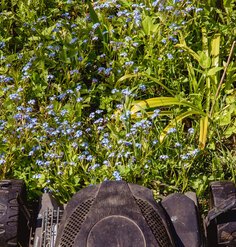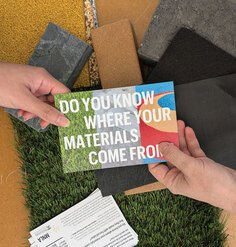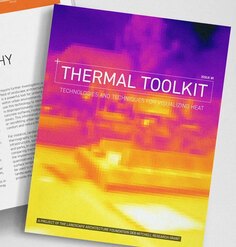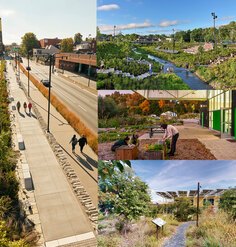From the Field: International Hurdles and Chance Relationships
By Kevin Eidick, MLA Candidate, University of Manitoba
Participating in LAF’s Case Study Investigation (CSI) program has been an extremely exciting experience so far. While I have to admit, my familiarity with the Landscape Performance Series website was little more than a quick click and overview in the past, this process has introduced me to such a vital resource that I will surely be revisiting during my remaining scholastic and professional career. This opportunity has exposed me to such a diverse breadth of projects and knowledge in landscape architecture and planning that boast some amazing environmental and socioeconomic benefits. Even more exciting is that these claims and performances are measured and backed up with some solid data.
My CSI research team is based in Winnipeg, Canada, and we are studying projects in the Riyadh Province of Saudi Arabia. Being one of few international research teams, and studying a project outside of the U.S., we were met with some unique hurdles. Firstly, many of the tools in the Landscape Performance Series Benefits Toolkit (for example, iTree, National Tree Benefit Calculator, and the National Stormwater Calculator) were developed for the U.S. They may not be appropriate to other countries or may require creative adaptations, such as using similar species or climate zones to estimate tree benefits in iTree.
We are investigating to see if we can modify variables within some of these software programs to more accurately represent the benefits in such a unique region of the world. Trying to find international equivalents to some of the software opened up the realization that most environmental agencies do not invest in similar tools. (Or perhaps they do exist but are not as readily available to the public.) It is impressive and commendable that federal agencies like the EPA and USDA offer such comprehensive resources.
While faculty Research Fellow Jean Trottier was familiar with the projects and their context, going into CSI I knew very little about Saudi Arabia and even less about the city of Riyadh. I was quite concerned about pursuing measurements of our projects’ social benefits since most of the Landscape Performance Series case studies rely on questionnaires or surveys in their assessments. Given the more than 12,000km distance between our research team and the projects, as well as the social conventions in Saudi Arabia, public surveys would be impractical. This forced us to be creative and look at different social media aggregators as a way to assess the increase in project use or significance. We are also finding indirect indicators of use — the parks’ toilet blocks! However, we are not sure if we can develop a statistically solid model on this…unique… form of measurement.
I didn’t want our case studies to provide only a superficial overview of Riyadh’s social attitude towards the projects along the Wadi Hanifah. Yet we didn’t know Arabic, nor any Saudis personally who could offer opinion or insight on what some of these projects mean to them. The universe works in mysterious ways, and it seemingly threw me a bone. At the peak of my frustration with navigating the social benefits of the projects, I was fortunate enough to meet a neighbour in the apartment complex I had recently moved to. This neighbour, Farhan, had moved to Canada in 2013 after spending half a decade working at the King Saud University in Riyadh where his commute took him along the parks of Wadi Hanifah every morning.
With the Wadi Hanifah as the initial catalyst for conversation, this chance relationship has grown into a budding friendship. Farhan explained to me his experiences in the parks, how these experiences differ when he is there with his young family. He also gave me great insight on some of the social and cultural norms that exist in Saudi Arabia. It is interesting to see how the design of these projects responds to the cultural context of Riyadh. While there were some striking similarities between car-oriented North American cities and Riyadh (apparently their morning commutes have gruesomely endless bumper to bumper traffic that could give Los Angeles a run for its money), the Saudis are a much more private society with much less exuberance and flare in their public domain.
It has been quite interesting to hear what are some of the most successful spaces in the Wadi Hanifah public parks from a citizen’s point of view. For example, the semi-circular seating areas with large limestone slab walls delineating more private areas offer families more intimate and comfortable spaces to enjoy the park and are heavily used on a daily basis. Similar to us Canadians and to our American neighbours, the Saudis also love to barbecue and use the public cooking areas in the parks to break the ice with strangers — inviting random passersby for a bite to eat and subsequent conversation.
Farhan has helped me navigate some interesting information (all in Arabic of course) that may inform our team as we delve further into the research process. Through this opportunity with CSI, I have been fortunate to meet a new friend, learn about a vibrant Saudi culture, learn more about Islam, and better inform myself on a part of the world I would otherwise not have been so thoroughly exposed to.
Research Assistant Kevin Eidick and Research Fellow Jean Trottier are participating in LAF’s 2015 Case Study Investigation (CSI) program and working to evaluate the environmental, economic and social performance of three projects that are part of the Wadi Hanifah Civic Parks and Comprehensive Development Plan in the Riyadh Province of central Saudi Arabia. Any opinions expressed in this article belong solely to the author. Their inclusion in this article does not reflect endorsement by LAF.











